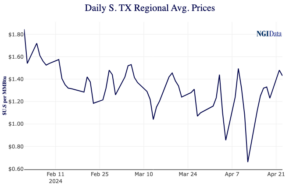LNG | Infrastructure | LNG Insight | NGI All News Access
LNG 101: Higher Stakes Seen for U.S. Exports with Atlantic Hurricane Season Underway
© 2024 Natural Gas Intelligence. All rights reserved.
ISSN © 1532-1231 | ISSN © 2577-9877 |

M&A
Privately held exploration and production (E&P) firms in the Eagle Ford Shale and Midcontinent regions could prove attractive targets for public producers seeking exposure to future strengthening of natural gas prices, according to Enverus Intelligence Research (EIR). EIR’s Andrew Dittmar, principal analyst, highlighted the Eagle Ford, the South Central Oklahoma Oil Province (SCOOP) and the…
April 24, 2024Markets
By submitting my information, I agree to the Privacy Policy, Terms of Service and to receive offers and promotions from NGI.